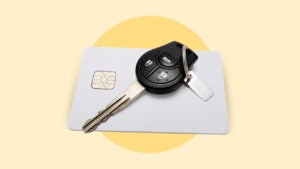“Can I have $20?”: When to give your child a debit card




Key takeaways
- Giving a child a debit card can teach them financial responsibility and budgeting skills at a young age.
- Most banks offer checking accounts and debit cards for teens as young as 13 years old.
- The decision to give a child a debit card should be based on their individual readiness and responsibility level.
- Features like parental controls and frequent money meetings can help children use debit cards responsibly.
Teaching financial literacy to teens and kids can have a meaningful impact on their financial futures. One effective way to provide a child with financial management experience is to teach them how to use a debit card. Young people can learn financial independence and how to budget their money.
The key, of course, is to figure out at what age you should give your child a debit card. Not only do you need to make sure your child is ready for the responsibility, but you’ll also need to check with your bank to find out if there are any age requirements before a child can get a debit card in their name.
At what age can a child get a debit card?
Since most states require people to be of legal adult age to open a checking account (18 years old in most states), you might be wondering how when you get access to a debit card for your child. Many banks offer checking accounts specifically for teenagers as young as 13 years old. Minimum age requirements and types of accounts will vary, so be sure to check with your financial institution ahead of time.
Typically, a parent or guardian will need to co-sign for the account until the child is 18 years old, when they can transition to a traditional checking account. You may be asked to provide documentation for yourself and your child, such as valid identification and the child’s birth certificate. Once the account is opened, both of you will be issued a debit card.
Financial benefits of a debit card
A debit card can offer a number of financial benefits to users of any age. If you think you might be ready to help your child open a first debit card, here are some of the perks that debit cards for kids and teenagers could provide.
- Convenience. Having a debit card makes it easier to make purchases — both in person and online — without having to carry around cash.
- Security. If your child loses their cash or someone steals from them, they might not ever be able to recover those funds. A lost or stolen debit card, however, may be eligible for certain protections under the Electronic Funds Transfer Act (provided you report the problem in a timely manner).
- Sending money. The best debit cards for teens can make it easier to send money or to pay your children an allowance with an electronic transfer.
- Money management skills. Some parents give their kids a set amount of money to use with their debit card each week or month. This structure can help demonstrate two important lessons — the importance of budgeting and the dangers of overspending.
It’s worth noting that credit cards can offer many of the same benefits above — but most children are too young to open credit accounts of their own, and a debit card is a much better way to learn about swiping, tapping, making purchases online and managing account balances. If you want to help your child establish credit before they leave the nest, you might consider making your child an authorized user on your credit card — but you’ll want to carefully consider the pros and cons of debit cards vs. credit cards before making your decision.
When to give your child a debit card
There are many reasons to give your kid a debit card — but how old should your kids be when you first give them access to debit? If you’re waiting for your child to be the “perfect” age to manage the financial responsibilities associated with debit cards, you might feel frustrated — and your kids might miss out on potential learning opportunities. Every parent needs to weigh a number of different factors when deciding whether their child is ready for a debit card.
Ages to consider
It’s wise to teach kids about money at an early age. In fact, your kids are likely learning about money through observation without you even realizing it. Of course, the techniques you use to teach your children above money may evolve as they grow older. A young child who isn’t ready to carry a wallet or track spending on a smartphone app probably isn’t ready for a debit card. A middle schooler, teenager or college student, on the other hand, might be better prepared for the responsibilities.
Remember, you know your child better than anyone else knows them. That makes you the most qualified to make the decision about what ages to give your child a debit card.
First job
One of the best times to introduce debit to your kids is when they first start earning their own money. Whether they’re working a summer job or providing babysitting services to the neighbors, the process of earning and managing their own income can provide your child with the chance to learn critical money lessons — and adding a debit card to the mix can give your son or daughter an opportunity to practice making good choices with the money they earn.
New drivers
If you have teenagers or young adults who recently started driving, setting your kids up with one of the best debit cards for teens can be helpful in several ways. In addition to teaching financial responsibility for teenagers, a debit card can provide access to cash for gas or financial resources in case an emergency situation arises.
When your child frequently asks for money
Another clue that it might be time to set up a debit card for your child is if your son or daughter starts repeatedly asking for money. In some cases, a debit card can curb the constant requests for a few extra dollars here and there—in other cases, a debit card can help children learn how to save money for future goals instead of spending everything in their account as soon as they receive it.
Many parents give their child a set sum of money each month or week — perhaps as a chore-based allowance that must be earned. Once your child begins receiving regular deposits into their debit account, you can let your child know which types of expenses he or she will have to cover on their debit card and help them learn how to budget accordingly.
How to make sure your child uses a debit card responsibly
Learning how to use money is an important skill, but parents teaching financial responsibility to teenagers — or even younger children — need to develop their own skillsets. Here are three tips that can help you teach your child to use a debit card in a responsible way.
- Set clear rules. Before you give your child a debit card to use, it’s important to set clear expectations. Make sure your son or daughter understands which monthly expenses they’re expected to pay, when and where they can use their debit card and what actions they should take if an unexpected or emergency expense comes up.
- Take advantage of alerts and other parental controls, if available. The best debit cards for kids come with features that can help parents manage their child’s account. For example, you might be able to set up alerts, place spending limits and review spending reports on your child’s account. Not every bank offers these types of digital tools, which is why fintech services like Greenlight can be so useful when it comes to teaching financial literacy to teenagers. If your bank doesn’t have the features you’re looking for, you might want to shop around and review other debit cards for teens and kids to find a better fit.
- Have frequent money meetings. Before your kid starts using a debit card, it’s important to help them create a spending plan. The plan should clearly define any expenses for which your child is responsible — snacks, gas, streaming services, etc. — along with savings goals. Once your child has created a budget, you’ll want to meet with them frequently to be sure they stay on course. If you find that your son or daughter is overspending on unplanned or variable expenses, it opens the door for discussions about financial priorities and saying no to impulse purchases.
The bottom line
Giving your child a debit card is a key step in helping your children learn important financial literacy skills that can provide them with critical money management experience before they enter adulthood. Before you sign your child up for one of the best debit cards for kids, ask yourself whether your child is ready for the financial responsibility — and be prepared for them to make common money mistakes, such as going over their budget or spending too much of their allowance on impulse purchases.





